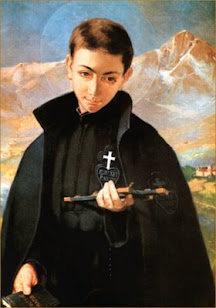Today, as Lent approaches, we celebrate the feast day of Saint Catherine de Ricci (born 1522, deceased 1589). Known for her sanctity and piety, Saint Catherine was both a mystic and a stigmatist, who spent her days serving others and deeply contemplating the Passion of Our Lord. Her devotion to the suffering of Jesus, coupled with her own personal suffering, led her to experience a beautiful “Ecstasy of the Passion” every week, from Thursday at noon until Friday at 4 p.m., for several years. In her ecstasy*, Catherine experienced the stages of Our Lord's Passion, actually realizing, and showing forth to others with wonderful vividness, all that His Blessed Mother suffered in witnessing it.
*Ecstasy, as recognized by the Church, is defined as a state which, while it lasts, includes two elements: (1) when the mind rivets its attention on a religious subject, generally internal and invisible to others; (2) when the activity of the senses is suspended, so that not only are external sensations incapable of influencing the soul, but considerable difficulty is experienced in awakening such sensation, generally visible to others through observable bodily signs. Many saints throughout the ages have been blessed with ecstatic experiences. Those of Saint Catherine de Ricci have been well studied and authenticated by the Church.
Catherine was born to a wealthy family in Florence, Italy. When her mother died, Catherine was raised by a loving and devout stepmother, who immediately recognized the holiness and sanctity of her charge. Even in infancy, Catherine was prone to spending long periods of time in solitary prayer, a practice her stepmother encouraged. In her youth, Catherine was determined to join a religious order, but none she encountered were serious enough for her, their rules too relaxed for her devotion to the Lord. At age fourteen, finding what she wanted, Catherine entered the Dominican convent of San Vincenzo in Tuscany. Her early years in the convent were marked by suffering and humiliation at the hands of the community. Her supernatural gifts of mysticism were not well understood, but eventually her sisters came to recognize her faith, humility, and service to others. Shortly thereafter she was chosen as Mistress of Novices, and at age 25, the community embracing her calling, Catherine was made Perpetual Prioress of the Order.
Gaining her position so young, Catherine served as counsel to many, including three future popes (Marcellus II, Clement VIII, and Leo XI). She corresponded supernaturally with Saint Philip Neri (“The Apostle of Rome, feast day: May 26), and she is reported to have miraculously appeared to him in visions during his life (they never having physically met).
Throughout her life, Catherine endured countless physical ailments and sufferings, the remedies offered at the time seemingly only increasing the severity of her symptoms. Despite her suffering, she engaged in extreme fasting and penance, and is said to have worn a heavy iron chain around her neck in recognition of the chains of sin that Jesus loosed for all humanity. As Father Stephen Razzi, a Dominican Friar who knew her, wrote in 1594, “Her obedience, humility, and meekness were still more admirable than her spirit of penance.” She was known for treating the poor, sick, and ill, traveling the countryside on her knees in service and humility to others.
Saint Catherine’s experience of the Passion of Our Lord occurred for twelve years, until she and the community prayed for it to stop. The attention and the visitors the convent was gaining due to her ecstasy had become disruptive to the Rules of the Order. During her weekly experience, Catherine’s body was tortured, allowing her sisters to follow the Passion step by step. Catherine would bleed as if being scourged, her forehead would run with blood as if she were being crowned with thorns, a large indentation on her shoulder appeared where Jesus had carried the cross. She further experienced the stigmata and bled from a wound in her side where the lance had been thrust. During these moments, and other moments of deeply penitential prayer, a coral ring would appear on Catherine’s finger, a sign of her marriage to the suffering of Christ. During her first ecstatic experience, she was presented with The Canticle of the Passion (text found below) by Our Blessed Mother—a prayer which Mary urged her to share with others, so that they, too, may contemplate the sufferings of the Lord.
Saint Catherine died in 1589, her body having suffered both the trauma of the Passion, as well as a long illness. Her remains repose in the Convent of San Vincenzo where the Dominican Order still serves the Lord and the world.
As we prepare to begin our Lenten journeys leading up to the Passion of the Lord on Good Friday and His glorious resurrection on Easter Sunday, we look to the faith, sacrifice, and suffering of Saint Catherine de Ricci. In her suffering, she experienced the joy of union with Christ. We can experience our daily sufferings in the same way, by linking our hardships in prayer and contemplation to those of Jesus-- remembering that without the suffering, there is no redemption; without the darkness of the crucifixion, there is no glory of the resurrection; without sacrifice, there can be no true joy.
THE CANTICLE OF THE PASSION
My friends and My neighbors
have drawn near and stood against Me.
I was delivered up and came not forth;
My eyes languished through poverty.
And my sweat became as drops of blood,
trickling down and upon the ground.
For many dogs have encompassed Me
the council of the malignant hath besieged Me.
I have given My body to the strikers
and My cheeks to them that plucked them.
I have not turned away My face from them that rebuked Me
and spit upon Me.
For I am ready for scourges,
and My sorrow is continually before Me.
The soldiers, plaiting a crown of thorns, placed it upon My head.
They have dug My hands and feet;
they have numbered all My bones.
And they gave Me gall for My food;
and in My thirst, they gave me vinegar to drink.
All they that saw Me laughed Me to scorn;
they have spoken with lips and wagged their heads.
They have looked and stared upon Me;
they parted My garments among them and upon My vesture they cast lots.
Into Thy hands I commend My spirit;
Thou has redeemed me, O God of truth.
Be mindful, O Lord, of Thy servants,
when Thou shalt come into Thy kingdom.
And Jesus having cried out with a loud voice
gave up the ghost.
The mercies of the Lord
I will sing for all eternity.
Surely He hath borne our infirmities
and carried our sorrows.
He was bruised for our sins.
All we, like sheep, have gone astray;
every one hath turned aside into his own way.
For the Lord hath placed upon him
the iniquities of us all.
Arise, why sleepest Thou, O Lord?
Arise and cast us not off to the end.
Behold, God is my Savior,
I will deal confidently, and will not fear.
We beseech Thee, O Lord, help Thy servants
whom Thou hast redeemed with Thy Precious Blood.
Have mercy on us, O benign Jesus.
Who in Thy clemency didst suffer for us.
Look down, we beseech Thee, O Lord, on this Thy family for which Our Lord Jesus Christ did not hesitate to be delivered into the hands of the wicked, and suffer the torments of the Cross.
Day 44 of 365
Prayer Intentions: To find the joy of Christ in our suffering
Requested Intentions: For the renewed marriage of a son and daughter-in-law (V); For a niece suffering with autism, and for all those affected by autism (V); For a daughter’s employment (J); For a son’s employment and growth in faith (M); Those planning for surgery (L); Those who are unemployed or in danger of losing jobs (A); Those fighting depression (L); For a growing love of the Eucharist and peace within a family (A).
Special Intentions (Day 3 of 45-day Novena to Our Blessed Lady of Lourdes): The intentions of all those who read this blog, whether submitted or retained in the quiet of their hearts; Penance, Penance, Penance for sinners; For all those who are suffering.
Why pray the Rosary every day for a year?
Each time the Blessed Virgin has appeared-- whether it be to Saint Bernadette Soubirous at Lourdes; to Lucia, Jacinta, and Francisco at Fatima; or to Mariette Beco at Banneux-- she has asserted the importance, saving grace, and power of praying the Holy Rosary on a daily basis. Based upon her words, the Rosary is penance and conversion for sinners, a pathway to peace, an end to war, and a powerful act of faith in Jesus Christ. Pope Paul VI presented the Rosary as a powerful means to reach Christ "not merely with Mary but indeed, insofar as this is possible to us, in the same way as Mary, who is certainly the one who thought about Him more than anyone else has ever done."
To show us how this is done, perhaps no one has been more eloquent than the great Cardinal Newman, who wrote: "The great power of the Rosary consists in the fact that it translates the Creed into Prayer. Of course, the Creed is already in a certain sense a prayer and a great act of homage towards God, but the Rosary brings us to meditate again on the great truth of His life and death, and brings this truth close to our hearts. Even Christians, although they know God, usually fear rather than love Him. The strength of the Rosary lies in the particular manner in which it considers these mysteries, since all our thinking about Christ is intertwined with the thought of His Mother, in the relations between Mother and Son; the Holy Family is presented to us, the home in which God lived His infinite love."
As Mary said at Fatima, "Jesus wants to use you to make Me known and loved. He wishes to establish the devotion to My Immaculate Heart throughout the world. I promise salvation to whoever embraces it; these souls will be dear to God, like flowers put by Me to adorn his throne."
Subscribe to:
Post Comments (Atom)




0 comments:
Post a Comment
Thanks for leaving a comment. If you wish to submit a prayer request, however, please do so above, using the "Contact" tab.